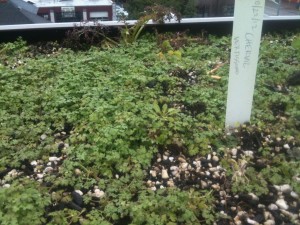We’re going to start off here with some light banter about chervil, but by the end of the post we’ll have delved into one of the greater questions of organic gardening. Plus, we may also have resolved why I’m putting that darn -s and -es at the ends of words which don’t need it.
So our photo, albeit not Ansel Adams quality, shows a bed carpeted with chervil. As one of the delicate French “fines herbes” (Blame the French for the extra letters at the end. We’d call them fine herbs, and in classical cooking parlance they include parsley, tarragon, and chives.), this little plant has the power to send chefs into paroxysms of delight. It is slow growing and does bolt (run to seed) easily in warm weather, so it’s not always the most commonly found item in the garden…a bit hard to keep around and somewhat similar to cilantro in that way. One of the beauties of the mild winter in the Pacific NW is that chervil abounds. It favors the cool growing conditions that our winters provide, and a few fall seedings should keep one in perma-chervil throughout the winter.
This last fall, I bought a large quantity of seed from Johnny’s Selected Seed and just scattered it willy-nilly around the rooftop garden, and now we are enjoying a small forest of the stuff, to the delight of the kitchen staff. I digress by observing that the seed is unique among the edibles I have grown in that it resembles mechanical pencil leads snapped into small pieces, providing a totally different finger feel to seeding than, say, the little balls which are the Brassicas or the gritty, carbony Allium family seeds. But most people, including even the nutso among the garden set, are probably not choosing plants based on the finger feel of their seed, so I move on. Similar to the mache which I mentioned a few posts ago, chervil serves as an edible carpet or cover crop, which seems to me the best use of precious garden space.
This brings us to the larger question of the use of cover crop in small gardens. Cover crops have multiple functions, which may include fixing nutrients like nitrogen, accumulating organic matter, and suppressing weed growth. Cover crops’ contributions become quite important in a large garden or farm because it is costly to provide the nitrogen, add organic matter, or suppress weeds in other ways, but, and maybe I am preaching OG heresy here, in the small garden, the limits of space and the time required to grow cover crops lead me to leave them by the wayside. For one thing, in both cost and labor I can pretty effectively fertilize with purchased amendments or roof-made compost, and because the garden is small and intensively planted, weeds aren’t a major concern (I can sense the grumbles of “Unfair!”). Because we are driven by the value of a high return on limited space and because we have so many crops that can grow through our winter, I accept a plant as a cover crop only if it has value for the restaurant. My sincere apologies go out to all the field peas, fava beans, vetches, clovers, and cereal ryes doing yeoman work in so many corners of the temperate world, but on the rooftop you don’t make the cut.
Mache, parsley and chervil…now thems fines cover croppes!

